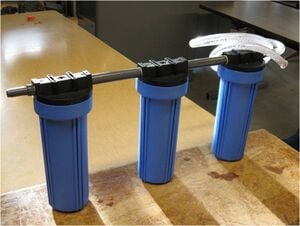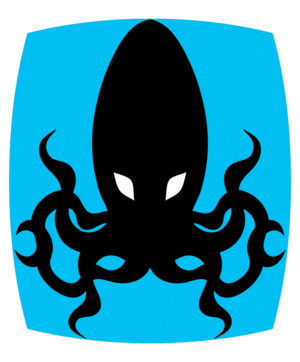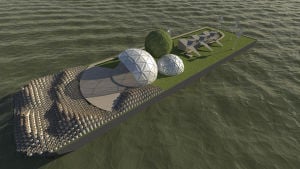

This page is about the Filter Commander 9000, a project made by The Pod People, a student team from an Engr205 class at Cal Poly Humboldt. The project started as a request for a water filtration system for the Waterpod project, and went through a five-stage design process before ending up as the Filter Commander 9000. This page is designed to show its progression from design to construction to use, and to present information for those who may want to replicate the system.
Background[edit | edit source]

The Waterpod Project started as a demonstration of a self-sustaining community, which would have a minimal environmental impact, and have its residents use sustainable methods of living. Their community is built entirely on a refurbished barge, and as such will be isolated from most modern utilities, such as the electrical grid and water supply. The barge itself will be located in the waterways of New York City, traveling to each borough and allowing visitors to observe the barge and its use of sustainable and appropriate technology. A majority of their potable water is from collected rainwater, and because of this they needed a proper filter to make it suitable for human consumption. The project to create the filter eventually produced the Filter Commander 9000.
Project Statement and Criteria[edit | edit source]
The focus of the Filter Commander 9000 was to create a water filter for the Waterpod project, but within a set of limitations. The filter must be able to filter captured rainwater to a degree that it can be imbibed by humans with no ill health effects, and will also fit as many of the criteria as possible to an acceptable level. Combined with the requirements set forth by the Waterpod team itself, the following set of criteria were tabulated via Delphi matrix:
Criteria[edit | edit source]
| Criteria | Description | Weight |
|---|---|---|
| Safety | The filter must be totally safe and produce water that is safe for human consumption. | 8.3 |
| Durability | It must be able to withstand and continue operating in adverse weather conditions, which could potentially lessen or compromise its effectiveness. | 8.3 |
| Ease of Use | Every person living on the Waterpod barge should be able to operate the Filter Commander 9000 with little to no training, and its upkeep should be simple to explain and carry out. | 8.3 |
| Cost | The Filter Commander 9000 must be inexpensive, both to construct and to maintain. Budget is a concern, especially because of the limited resources of both the Waterpod team and The Pod People themselves. | 7.3 |
| Educational Value | As the barge is meant to both sustain its inhabitants and educate the public on sustainability, the Filter Commander 9000 should be made in such a way so that it will teach visitors about both sustainable living and water filtration, specifically. | 6.3 |
| Personal Interest | Each team member should have an interest in both the design and success of the Filter Commander 9000, and should want to learn from the design experience. | 4.7 |
| Aesthetics | While rated as the least important, the Filter Commander 9000 itself should look at least professional and should inspire confidence in the people that will be relying on it to create clean water for their use. | 3.7 |
All of these criteria were taken in consideration for the Filter Commander 9000's construction.
Final Design[edit | edit source]
After several drawing-board designs and many revisions, the result was the Filter Commander 9000: a series of three linked water filters with progressively finer and finer filters. Each filter is of a standard 10' size and housed within a plastic casing, between which water is pumped through lengths of 3/4" PVC pipe. The three filters were:
| Filter | Purpose | Pore Size |
|---|---|---|
| One Polyspun Plastic Sediment Filter | Filters out large particulate matter, BOD; anything that might clog the later filters | 20 micron |
| One Carbon-Impregnated Filter | Filters medium to small particulate matter; anything not caught by the first filter | 5 micron |
| One Silver-Impregnated Ceramic Filter | Filters out tiny particulate matter, as well as most pathogens and heavy metals | ~.9 micron |
The exterior of the Filter Commander 9000 consists of three 10" filter housings (with 3/4" threading) connected by 6" lengths of PVC pipes, with an input and output nozzle installed on each end. One end is connected to the collected rainwater supply, the other is open for any available container or pipe for collecting the filtered water. Each filter is held firmly in place by brackets built into the lid and base of each filter housing.
-
Fig. 1: Exterior diagram of the Filter Commander 9000, drawn in CAD.
-
Fig. 2: A cutaway CAD drawing of the filter inside of its housing. Blue arrows denote the flow of water through the system.
-
Fig. 3: Filter Commander 9000, fully assembled and with a hose attached.
-
Fig 4: Glamor Shot of Filter Commander 9000.
The pressure needed to push water through the system was tailored to the Waterpod's specifications, and was provided with a pressurized water reservoir with a pressure of 50 pounds per square inch, which is more than enough to cause the system to function. Without it, gravity can provide enough pressure to filter the water, though at a drastically reduced rate.
Costs[edit | edit source]
During the design process, the Filter Commander 9000 was given a maximum cost ceiling of $225, under which the entire project's costs must fall.
| Component | Quantity | Total Cost |
|---|---|---|
| 20-micron Polyspun sediment Filter | 3 | $9.00 |
| 5-micron Carbon-Impregnated Filter | 3 | $18.00 |
| .9-micron Silver-Impregnated Ceramic Filter | 1 | $30.00 |
| 10" Filter Housings | 3 | $25.68 |
| PVC Pipe Connectors | 4 | $16.43 |
| Replacement O-rings for Filter Housings | 3 | $8.37 |
| Housing Wrench (For tightening the Housings' lids) | 1 | $4.79 |
The total cost for the Filter Commander 9000 came to $112.27, just under half of the maximum cost allowance. None of the parts were bought at any appreciable discount, and because they are standard parts these costs are about average for water filters and components online.
Conclusions[edit | edit source]
Overall, the Filter Commander 9000 met all of its project criteria, as well as meets NSF Standards for drinking water. The system has no moving parts and can be easily repaired and maintained by the residents of the Waterpod barge.
The system will be shipped in pieces, with its filters and their replacements included, to the Waterpod barge by the 1st of June, in time for the barge's maiden voyage. It will be constructed on-site.
References[edit | edit source]
- United States
- Projects
- Devices
- Waterpod
- SDG06 Clean water and sanitation
- SDG11 Sustainable cities and communities
- Filters
- Alternative building
- Appropriate technology
- Green household
- Green living
- Water
- Water and sanitation for developing countries
- Water conservation
- Water distribution
- Water filters
- Water purification
- Water quality
- Water recycling
- Water supply
- Water treatment



